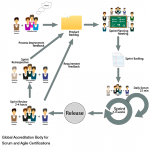Scrum as an Agile methodology is currently most popular in IT development teams. However, that does not mean that it cannot be effectively used in other domains. In fact, as an Agile methodology of managing projects, it can be used wherever people work on projects. It can be used in a particular division of a company – like new product development in an automobile company, or across a function. This article will highlight how Scrum methods can be used very effectively to manage HR projects.
HR as a function revolves around managing people and policies. A lot of the teams in HR are involved in managing HR operations. However, when it comes to launching a new HR initiative like a leave management system or conducting induction programs etc., then managing such projects effectively becomes key to their success. For that, it is essential for the various team members to work together as a cohesive unit. This is what Scrum can help HR teams with. Let’s see how.
Let’s say the HR team is tasked with the project of launching a leave management system. How can it use Scrum? Well, it actually is quite simple (one of the basic objectives of Scrum – to keep it simple). You start off with stating the project vision – designing a leave management system for employees of a particular office location as a pilot project. Then you need someone to spearhead the whole project – the Scrum Master. He/she will decide who all will be part of the Scrum team. These have to be people who will actually be doing the various tasks in the project and not the ones who simply have an interest in the project.
So now you have the people who will be working on the Scrum project. What next? The team needs to understand the customer requirements. These are defined in the form of User Stories. In our case, two of the user stories might be ‘I would like to be able to record my attendance even if I forget to get my identity card’ and ‘As a manager, I would like to get weekly attendance summary in an easy to read format for all my team members’.
The User Stories are approved and entered into what is called the Prioritized Product Backlog. It is the master document which guides the team in the project. It contains the User Stories and the tasks which are required to fulfill the requirements for each of the user stories. So in our example, the first User Story about attendance recording will include tasks like ‘Identify alternative attendance recording systems like biometric identification’, ‘Decide the parameters on the basis of which the recording system will be chosen’, ‘Issue RFP in the newspapers’, etc. It then decides on a Release Planning Schedule which lays out the schedule of shipping out completed deliverables to the customers – in this case, a completed deliverable might be the decision on the final vendor who will implement the attendance recording system. The team then estimates the time required for the various tasks. Based on the above, a collective decision is taken on which all tasks will be taken up in the first round – called Sprint in Scrum. A Sprint duration can vary from a week to a few weeks.
The team then works on completing the tasks in a particular Sprint. To ensure that things are on track, the Scrum team has a Daily Standup Meeting which is time-boxed to normally 15 minutes to half an hour, in which all the members stand around and discuss the status of the different tasks. Given that HR teams would need to interact on a daily basis, the Daily Standup Meetings would be a more structured way to conduct their daily interactions. Tasks are entered in post-it notes and stuck on to a whiteboard with 3 columns – ‘To be done’, ‘In Process’ and ‘Completed’. As the team works on the tasks, the tasks from the first column to the third column. At the end of a Sprint, when the team has hopefully completed all the tasks, a Sprint Review Meeting takes place where the team discusses what went right and what are the improvement opportunities. At designated points in time as laid out in the Release Planning Schedule, the team ships out completed deliverables to the customers, which might be the top management and IT team.
This process continues till all the deliverables and tasks are completed in the HR project. The high level of involvement and communication involved in the Daily Standup Meetings is the key to an effective implementation of Scrum. Thus, by following the above process, HR teams can ensure speedy completion of projects with high quality outputs without getting bogged down by a lot of documentation and processes.
Note: The Scrum specific terms used in this article are as per the Guide to the Scrum Body of Knowledge (SBOKTM)









